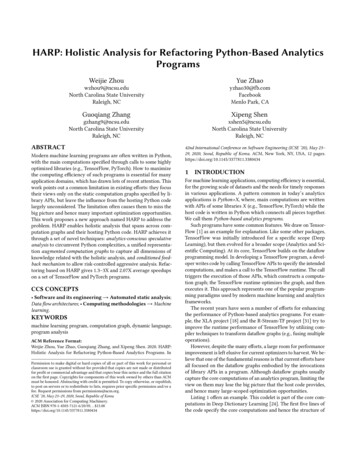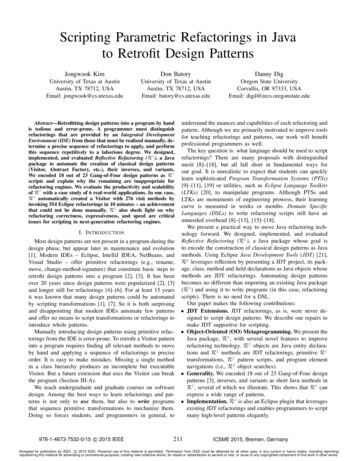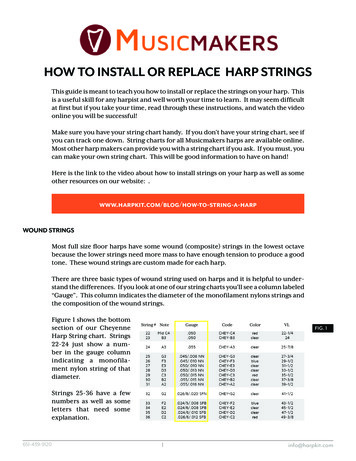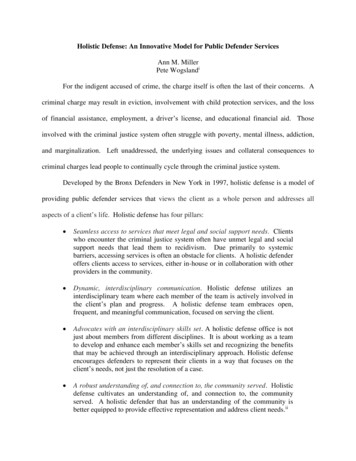
Transcription
HARP: Holistic Analysis for Refactoring Python-Based AnalyticsProgramsWeijie ZhouYue Zhaowzhou9@ncsu.eduNorth Carolina State UniversityRaleigh, NCyzhao30@fb.comFacebookMenlo Park, CAGuoqiang ZhangXipeng Shengzhang9@ncsu.eduNorth Carolina State UniversityRaleigh, NCxshen5@ncsu.eduNorth Carolina State UniversityRaleigh, NCABSTRACTModern machine learning programs are often written in Python,with the main computations specified through calls to some highlyoptimized libraries (e.g., TensorFlow, PyTorch). How to maximizethe computing efficiency of such programs is essential for manyapplication domains, which has drawn lots of recent attention. Thiswork points out a common limitation in existing efforts: they focustheir views only on the static computation graphs specified by library APIs, but leave the influence from the hosting Python codelargely unconsidered. The limitation often causes them to miss thebig picture and hence many important optimization opportunities.This work proposes a new approach named HARP to address theproblem. HARP enables holistic analysis that spans across computation graphs and their hosting Python code. HARP achieves itthrough a set of novel techniques: analytics-conscious speculativeanalysis to circumvent Python complexities, a unified representation augmented computation graphs to capture all dimensions ofknowledge related with the holistic analysis, and conditioned feedback mechanism to allow risk-controlled aggressive analysis. Refactoring based on HARP gives 1.3–3X and 2.07X average speedupson a set of TensorFlow and PyTorch programs.CCS CONCEPTS Software and its engineering Automated static analysis;Data flow architectures; Computing methodologies Machinelearning.KEYWORDSmachine learning program, computation graph, dynamic language,program analysisACM Reference Format:Weijie Zhou, Yue Zhao, Guoqiang Zhang, and Xipeng Shen. 2020. HARP:Holistic Analysis for Refactoring Python-Based Analytics Programs. InPermission to make digital or hard copies of all or part of this work for personal orclassroom use is granted without fee provided that copies are not made or distributedfor profit or commercial advantage and that copies bear this notice and the full citationon the first page. Copyrights for components of this work owned by others than ACMmust be honored. Abstracting with credit is permitted. To copy otherwise, or republish,to post on servers or to redistribute to lists, requires prior specific permission and/or afee. Request permissions from permissions@acm.org.ICSE ’20, May 23–29, 2020, Seoul, Republic of Korea 2020 Association for Computing Machinery.ACM ISBN 978-1-4503-7121-6/20/05. . . 15.00https://doi.org/10.1145/3377811.338043442nd International Conference on Software Engineering (ICSE ’20), May 23–29, 2020, Seoul, Republic of Korea. ACM, New York, NY, USA, 12 ODUCTIONFor machine learning applications, computing efficiency is essential,for the growing scale of datasets and the needs for timely responsesin various applications. A pattern common in today’s analyticsapplications is Python X, where, main computations are writtenwith APIs of some libraries X (e.g., TensorFlow, PyTorch) while thehost code is written in Python which connects all pieces together.We call them Python-based analytics programs.Such programs have some common features. We draw on TensorFlow [1] as an example for explanation. Like some other packages,TensorFlow was initially introduced for a specific scope (DeepLearning), but then evolved for a broader scope (Analytics and Scientific Computing). At its core, TensorFlow builds on the dataflowprogramming model. In developing a TensorFlow program, a developer writes code by calling TensorFlow APIs to specify the intendedcomputations, and makes a call to the TensorFlow runtime. The calltriggers the execution of those APIs, which constructs a computation graph; the TensorFlow runtime optimizes the graph, and thenexecutes it. This approach represents one of the popular programming paradigms used by modern machine learning and analyticsframeworks.The recent years have seen a number of efforts for enhancingthe performance of Python-based analytics programs. For example, the XLA project [18] and the R-Stream-TF project [31] try toimprove the runtime performance of TensorFlow by utilizing compiler techniques to transform dataflow graphs (e.g., fusing multipleoperations).However, despite the many efforts, a large room for performanceimprovement is left elusive for current optimizers to harvest. We believe that one of the fundamental reasons is that current efforts haveall focused on the dataflow graphs embodied by the invocationsof library APIs in a program. Although dataflow graphs usuallycapture the core computations of an analytics program, limiting theview on them may lose the big picture that the host code provides,and hence many large-scoped optimization opportunities.Listing 1 offers an example. This codelet is part of the core computations in Deep Dictionary Learning [24]. The first five lines ofthe code specify the core computations and hence the structure of
ICSE ’20, May 23–29, 2020, Seoul, Republic of Koreathe dataflow graph. Line 1 defines 𝐴 as a variable as its value needsto be updated through the execution; Lines 2 and 3 define 𝐷 and 𝑋as place holders for they will hold the input values; Line 4 specifiesthe formula for calculating the new value of 𝐴 through a series ofcalls to the high-level TensorFlow mathematics functions; Line 5specifies an update to 𝐴 with the new value. Line 6 is a Pythonloop statement, and Line 7 calls TensorFlow API "sess.run" (a blocking API) to invoke TensorFlow runtime to actually construct thedataflow graph and execute it; it passes the actual parameters 𝐷and 𝑋 to the two place holders.The following pseudo-code shows what the codelet implements:𝑓 𝑜𝑟 𝑖 𝐼𝑡𝑒𝑟 :𝐴 𝐷 (𝑋 𝐷𝑇 𝐴)where each of the capitalized letters represents a multidimensionalarray (called a tensor), and 𝐷 and 𝑋 are input tensors and remainconstant across the loop iterations.The implementation by the codelet in Listing 1 contains someredundant computations, which can be seen if we expand the mathematical formula in the pseudo-code to 𝐷𝑋 𝐷𝐷𝑇 𝐴. Because terms𝐷𝑋 and 𝐷𝐷𝑇 are invariant across the loop iterations, they can behoisted outside the loop, computed once and reused for all iterationsas shown as follows:𝑡 1 𝐷𝑋𝑡 2 𝐷𝐷𝑇𝑓 𝑜𝑟 𝑖 𝐼𝑡𝑒𝑟 :𝐴 𝑡1 𝑡2𝐴Even though the redundant computations are not hard to seeat the pseudo-code level, it cannot be recognized or optimized byeither TensorFlow or any of the previously proposed optimizersdesigned for TensorFlow programs. Moreover, even if we rewritethe code to better expose the redundancy as in Listing 2, prioroptimizers still cannot detect the redundant computations.The reason is that all these tools focus only on the dataflow graphcomposed through the TensorFlow APIs, while the redundancycomes from the interplay between those TensorFlow API calls andthe other Python code that hosts those calls. Take Listing 1 forinstance, without analyzing the host Python code, it is impossibleto tell that D and X are invariant across the for loop and hence𝐷𝑋 and 𝐷𝐷𝑇 are also loop invariants, as the computation graphdoes not capture the loop in the host code and its relation withthe data in the graph. On the other hand, general Python codeoptimizers cannot find out the redundancy either as they do notunderstand the necessary semantics of the TensorFlow APIs. Otherexamples include partially repeated computations involved twoseparate API calls, the mis-use of computation graph constructionAPIs as computation APIs in a loop and causing millions of graphnodes to be generated unnecessarily (See Section 4.3).This work proposes a new approach named HARP (HolisticAnalysis for Refactoring Python-Based Analytics Programs) to address the problem. We next gives an overview of HARP, the mainchallenges and our contributions.2OVERVIEW OF HARPTo overcome the aforementioned limitation of existing tools, aninitial option we considered was to create an automatic static codeoptimizer with a holistic view. It is however impractical: Python is aWeijie Zhou, Yue Zhao, Guoqiang Zhang, and Xipeng ShenListing 1: Example from Deep Dictionary Learning ("tf" forthe namespace of TensorFlow)1234567ADXR t f . V a r i a b l e ( t f . z e r o s ( s h a p e [N , N ] ) , d t y p e t f . f l o a t 3 2 )t f . p l a c e h o l d e r ( s h a p e [N , N ] , d t y p e t f . f l o a t 3 2 )t f . p l a c e h o l d e r ( s h a p e [N , N ] , d t y p e t f . f l o a t 3 2 )t f . matmul ( D , t f . s u b t r a c t ( X , t f . matmul ( t f . t r a n s p o s e ( D), A) ) )L t f . assign (A, R )f o r i in range ( I t e r ) :r e s u l t s e s s . run ( L , f e e d d i c t {D : D , X : X } )Listing 2: Listing 1 in a Different Form1234567.t 1 t f . matmul ( D , X )t 2 t f . matmul ( D , t f . t r a n s p o s e ( D ) )R t f . s u b s t r a c t ( t 1 , t f . matmul ( t 2 , A ) )L t f . assign (A, R )f o r i in range ( I t e r ) :r e s u l t s e s s . run ( L , f e e d d i c t {D : D , X : X } )dynamically-typed language, the complexities of which (listed later)form some major barriers for static optimizers to work effectively.A pure dynamic optimizer on the other hand is complicated todevelop and causes runtime overhead and delays.The strategy we finally took is to create a refactoring assistant,which provides suggestions for developers to use in refactoringthe code. This strategy allows aggressive analysis on incompleteinformation. Even though the suggestions may not be always correct, as the tool provides enough feedback on the assumptions ituses, the developers can avoid the risks while taking advantage ofthe often correct suggestions. HARP is the first tool that enablesholistic analysis that spans across dataflow graphs and their hostingPython code. HARP achieves it through several novel features:(1) Speculative analysis. HARP relies heavily on static analysis.As a dynamically-typed scripting language, Python poses manydifficulties to static analysis, such as unknown types, operator overloading, dynamic dispatch of higher-order functions, and so on.HARP circumvents the complexities with two key insights: ManyPython complexities rarely appear in analytics programs or canbe ignored; for those that do matter, they can often be treated successfully through speculations on common patterns in analyticsapplications. HARP materializes the insights through speculativeanalysis.(2) Uniform representation. Holistic analysis requires a coherentway with a uniform structure to represent the computations andrelations attained from both the host and the computation graph.The representation must be inclusive in the sense that it must contain necessary info from both the host and the library—includingnecessary high-level semantics (e.g., side effects, expected tensortype) of APIs. It, at the same time, must be amenable for automaticinferences for optimization opportunities. HARP introduces augmented computation graphs, a uniform representation that augmentscomputation graphs with relations attained from the host code andsome light annotations of library APIs. It uses Datalog as the mediato create the coherent representation for holistic analysis.(3) Informative and extensible interface. HARP employs a Datalogbased interface such that code analysis modules can be simply
HARP: Holistic Analysis for Refactoring Python-Based Analytics Programsexpressed in Datalog rules in a declarative manner. Through the interface, we equip HARP with a set of predefined rules for detectingcommon inefficiencies on the augmented computation graphs. Theinterface also allows users to easily extend HARP with extra rules.Meanwhile, we equip HARP with a conditioned feedback mechanism,through which, HARP gives users not only suggestions for coderefactoring but also the assumptions it holds in its speculations.This feature helps control the risks of the speculative analysis, andallows HARP to offer likely useful suggestions despite languagecomplexities.To evaluate the efficacy of HARP, we implement it as a plugin ofPyCharm based on IntelliJ1 and develop the support for TensorFlowand PyTorch. HARP is effective in finding optimization opportunities that are elusive to prior techniques. Code refactoring basedon the findings yield 1.3-3X performance improvement on a GPUmachine. We further conduct a user study, which helps confirm theproductivity benefits of this refactoring tool.We do not claim using Datalog for program analysis as our contribution. Many previous papers have applied Datalog for programanalysis and shown promising productivity [2, 14, 37–39]. The keycontributions of this work are four-fold: It points out the limited view of existing tools as a fundamental barrier to harvest important opportunities for refactoringmodern machine learning applications for performance. It provides several insights important for circumventing language complexities in machine learning applications, andproposes ways to leverage common patterns in machinelearning to enable effective speculative analysis. It develops augmented computation graphs as unified way tohost all dimensions of knowledge related with the holisticanalysis. It creates HARP, the first holistic analysis-based tool formachine learning code refactoring, and demonstrates itseffectiveness in a range of applications.The current implementation of HARP focuses on supporting TensorFlow and PyTorch [29] programs for their increasing popularity,and also for their representatives of two paradigms in computationgraph construction: TensorFlow builds static computation graphs,while PyTorch defines dynamic graph. We next provide some background knowledge and then describe each part of HARP in detail.3BACKGROUNDThis section presents background knowledge on TensorFlow, PyTorch, and Datalog.3.1TensorFlowA TensorFlow program works in a “define-and-execute” way [13].Its execution first creates a computation graph which then getsoptimized and executed by the runtime. High level languages suchas Python are often used as the host language in defining the computations, and low-level languages such as C-family languages areoften used to implement the runtime system for the purpose ofperformance efficiency. A TensorFlow program can be regardedas a mix of two program components: The first part, called "host1 http://www.jetbrains.orgICSE ’20, May 23–29, 2020, Seoul, Republic of KoreaAPIHostcodeComputationGraphexecuteSessionTF SystemFigure 1: High-level relations among host code, TF system,and computation graphs.program", contains the computation that is directly executed by thefront-end language. The second part is the computation representedby the “computation graph”.Computation graphs. In TensorFlow, the computation graph is adirected graph composed of a set of nodes and edges: Nodes instantiates operations (e.g., “matrix multiply” or “sigmoid”). Each operation can have zero or more inputs andzero or more outputs.These operations get dispatched to devices (CPU, GPU) bythe runtime. Edges represent the values communicated between operations. The most common types of values in TensorFlow aretensors, which are 𝑁 -dimensional arrays. Their elements canhave one of the primitive types (e.g., int32, float32, orstring). Tensors on edges are stateless and immutable. There are some special nodes and edges. For example, atf.Variable creates a variable, which represents statefulvalue and is mutable. It is represented as a node in the graphcarrying the variable name as its label. In addition, there arecontrol dependency edges which indicate controls of theexecution order of operations.Host program and graph execution. In a typical TensorFlow program, the responsibilities of the host program include preparingdata for the computation, hosting the API calls that define thecomputation graph, and controlling its executions.The host program interacts with computation graphs and theunderlying TensorFlow (TF) system through the session API. Itcalls session.run which prompts the TF system to execute thecomputation graph. The call may specify a set of output nodeswhose values are to be fetched, and a set of input tensors to be fedinto the graph. Figure 1 illustrates the relations.A computation graph can be executed multiple times. It is important to note that tensors do not survive across one execution of thegraph (e.g., one session.run); the memory holding them is allocatedand reclaimed automatically. In contrast, values of variable nodespersist across executions.3.2PyTorchPyTorch is another popular machine learning framework. Similarto the TensorFlow, the PyTorch program can also be regarded as amix of the Python host program and the underlying computationgraph of operations, which will be dispatched to runtime kernelsin the execution. However, unlike TensorFlow, the PyTorch buildsthe computation graph dynamically. In other words, the PyTorch
ICSE ’20, May 23–29, 2020, Seoul, Republic of KoreaWeijie Zhou, Yue Zhao, Guoqiang Zhang, and Xipeng ShenListing 3: An example machine learning codeletHost programHARP compiler&graph GraphAnalysis ruleAnalysis ruleLibrary APIInference ties(Offline)Figure 2: The overall system diagram.constructs the computation graph on-the-fly so the computationgraph can change every time it is executed.3.3DatalogDatalog is a popular logic programming language based on thefirst order logic. In Datalog, program logic is expressed in termsof relations, represented as facts and rules, and computations arein queries over these relations. Two basic constructs are term andatom. A term is either an entity (constant) or a variable2 . An atomis a predicate with a list of terms as arguments. It is in form of𝑝 (𝑋 1, 𝑋 2, . . . , 𝑋𝑛 ), where 𝑝 is a predicate and 𝑋𝑖 are terms. A groundatom or fact is a predicate with only constant arguments. Manyfacts together form a Datalog database.Datalog rules express logical inferences, in the following form:𝐴 : - 𝐵 1 , 𝐵 2 , . . . , 𝐵𝑛 .which reads “𝐵 1 and 𝐵 2 and . and 𝐵𝑛 together imply 𝐴”, whereeach symbol is an atom.A Datalog program is a collection of rules. When it runs on afact database, it infers a new set of facts by applying the rules to theknown facts. Datalog can define recursive relations and recursivequeries naturally and is declarative.4THE HARP SOLUTIONThis section presents HARP in detail. Figure 2 outlines the overall structure of HARP. HARP code analysis extracts the relevantinformation from the host code and the computation graphs, andrepresents them in a unified format, augmented computation graph,written in Datalog atoms. Meanwhile, through some light annotations, we equip HARP with the knowledge on the high-levelproperties of the library APIs, including the side-effects of APIs,argument types and returning types. With all the relevant information captured and represented in an analyzable manner, for a rule(predefined in HARP or given by users) describing code inefficiencypatterns, the Datalog inference engine can identify optimizationopportunities that span across boundaries between host code andAPI calls. HARP is equipped with a list of predefined rules on codeinefficiency, which are derived through our analysis of 112 realworld analytics applications, listed in Table 1 and elaborated inSection 4.3. We next explain HARP and how it addresses the mainchallenges in enabling holistic analysis.12345def d f d x ( x , param , f ) :z f ( x , param )z . backward ( [ t o r c h . o n e s l i k e ( z ) ] )dfdx v x . gradreturn d f d x v4.1Overcoming Language ComplexitiesThe first challenge this work encounters is Python complexities.As an important step outlined in Figure 2, the HARP analyzer mustcapture the important interactions between the host Python codeand the computation graphs. As a dynamically-typed scripting language, Python poses many difficulties to the static analysis, whichare summarized in Table 2. These complexities cause unknowntypes and undecidable operations or function calls.Listing 3 shows such an example. The function dfdx calculatesthe partial derivative of a function with regard to the input x. Dueto the dynamic feature of Python, it is hard for static analysis toprecisely determine the types of its input parameters.HARP circumvents the difficulties by leveraging insights obtained specially on analytics applications. The first insight is thatmany Python complexities rarely appear in analytics programs orcan be ignored. Table 2 reports the number of appearances of eachtype of complexity in 112 real-world analytics applications that wehave surveyed in two GitHub collections 3 . These two collectionscontain some TensorFlow and PyTorch programs representing avariety of tasks in machine learning, ranging from natural languageprocessing to image processing, object detection, and so on. In thesurvey, we ran our static Python code analyzer (sec 4.2.2) on eachof the programs, which reports places that give static analysis ahard time. We then manually examined those cases. Among the112 applications, the most frequent complexity is dynamic typechanges, but the frequency is still only 14.The second insight is that for those complexities that do matter,they can often be treated successfully through speculations.The speculations are based on some common patterns observedin analytics applications. Analytics applications, due to the common features of the domain, exhibit some patterns. For instance, inPyTorch code, the type of a variable that has a member function"grad" or "backward" is usually a tensor with all floating-point values. That pattern can then help speculate on the types of variables𝑥 and 𝑧 in Listing 3. Although using names for speculation is ingeneral not fully reliable, we observed that doing that for somecommon functions in machine learning domain gives correct speculations in most of times. Table 3 lists some of the patterns weattained through our studies on our collection of machine learningapplications. Listing 3 belongs to the second pattern in Table 3.When encountering a complexity in its static analysis of a givenPython program, HARP resorts to the common patterns. If theconditions match, HARP resolves the complexity speculatively.Such speculations allow HARP to carry on its code analysiseven in the presence of the complexities. That makes it possible toprovide refactoring suggestions that are likely (not guaranteed) tobe valid and beneficial. Speculations could be wrong; the developer3 https://github.com/jtoy/awesome-tensorflow;2 Byconversion, lowercase for constants and uppercase for chieng/the-
HARP: Holistic Analysis for Refactoring Python-Based Analytics ProgramsICSE ’20, May 23–29, 2020, Seoul, Republic of KoreaTable 1: Some Inefficiency Patterns Predefined in HARPNo.Inefficiency12Mistake the computation construction for computation execution (TensorFlow)Loop redundancyCode Patterns Use computation graph construction APIs inside loop. The APIs are primitive operators such as tf.add, tf.mul, etc. Loop invariant computation inside loop3Common subgraph computation Two consecutive executed computation graphs have common intermediate nodes. The value of the common nodes are invariant across the executions.4Plain for loop for computation (TensorFlow)5Miss performance tuning for static graph (PyTorch)6Scalar computation that can be vectorized Use the plain Python loop for building computation graph. The code inside the loop only reference nodes in the computation graph but notother data on the host side. The dynamically constructed computation graph remains the same across loops: noconditional branch or dynamic dispatch. Size of the input data is not changed. Iteration number is non-trivial ( 5). Simple for loop contains straight line code with neither function calls nor branches. Computation on vector data type (list of number, array, etc). No vector dependence.Table 2: Python language complexities for static analysisand appearing frequencies in 112 machine learning applications.Data dependent conditional branchStatic unknown function dispatchHigher-order functionCustomized operator overloadDynamic attribute settingDynamic type changesDynamic-typed container# programs with the complexity3410241412Class of patterns1Access to an object through its attribute, such as foo.bar, or anindex, such as foo[bar], is speculated as side effect free.The type of an object can be speculated based on the names ofits fields and methods visited locally if the names are commonmachine learning names (e.g., those in Figure 3).If a Python list is (speculatively) converted to a tensor, it isspeculated that the elements in the list share the same type.If all branches of a condition statement return variables withthe same type, they speculatively share the same type.I/O operations are normally used for loading data and logging,thus they are speculated as having no unexpected side effects.2345torch.utils.data.Dataset(), transforms.CenterCrop(),transforms.Normalize(), torch.from numpy(t),transforms.functional.adjust brightness(img ),torch.ones like(a), torch.add(a,b), Tensor[:,:,.],Tensor.abs(), Tensor.add(b), Tensor.min(), Tensor.copy(),Tensor.dim(), Tensor.size(), Tensor.permute(),Tensor.reshape(), Tensor.type as(), Tensor.float(),Tensor.detach(), Tensor.cuda(),Tensor.unsqueeze () .Figure 3: Some common function names used in HARP ashints for speculative analysis.needs to make the final judgment. To assist the developers in theprocess, HARP records all speculations, and reports them when itUnified Representation throughAugmented Computation GraphsFor holistic analysis, it is preferred that all the needed informationof the program is represented in an analyzable form. It implies threequestions: (1) what information to get, (2) how to get it, and (3) howto represent it. HARP answers these questions by following severaldesign principles: First, the representation should be amenable for softwareinference, but also easy to understand for humans. The representation can then be used for not only program analysis,but also as a kind of documentation. Second, the set of information to collect from the programare intended to be used in a variety of analysis; hence, theirdefinitions should be general rather than tailored to someparticular analysis. Third, the representation should also be extensible. Thus,specification for new properties and other sources of information can be added easily.Table 3: Some of the machine learning patterns leveragedfor speculative analysis.No.Do the computation inthe Session.Hoist the loop invariantout of the loopCache the last commonnodes and reuse thevalue.ReplacetheplainPythonloopwithtf.while loopTurn on the CUDAspecificoptimization tuning such astorch.backends.cudnnUse array or tensor typeand their vectorized operations.provides the corresponding refactoring suggestions, as Section 4.4details.4.2Python Language ComplexitiesPotential Optimization’sWe next explain the solutions from HARP in detail.4.2.1 Info to Attain: Semantic Definitions. The relevant information for holistic analysis comes from both the host Python code andthe computation graphs. For simplicity of explanation, we use "semantics" to refer to all4 . Both host code and the computation graphcarry many-fold semantics, defining the set that is most relevant tolarge-scoped inefficiencies is the key.Semantics from Computation Graph. As mentioned in Section 3, acomputation graph consists of two types of objects, nodes and edges.Each node represents an operation that consumes or producesvalues. Each edge represents the values that are output from, orinput to a node, namely, the values that flow along the edge. We useTensorFlow as the example to explain the set of semantics HARPcaptures from nodes and edges.4 Themeaning goes beyond traditional language semantics, referring to any propertiesor knowledge about a programming language construct.
ICSE ’20, May 23–29, 2020, Seoul, Republic of KoreaFor a node (TF operation), HARP captures four-fold semantics(1) control inputs, referring to the set of operations on which thisoperation has a control dependency; (2) inputs, which are the listof tensor inputs of the operation; (3) outputs, which are the list ofoutput tensors of the operation; and (4) type of computation, such asAdd, MatMul. HARP contains the set of common computation types,including those supported in ONNX [8], a standard for representingdeep learning models; more can be easily added.For an edge (TF value), HARP captures some important properties: kind, dtype, shape, constant or variable. The first, kind, is aboutwhich kind of edge it is. We distinguish two different kinds of edgesbased on their different purposes [1]: Tensor edges convey the immutable tensors of the data. InTensorFlow, all data are modeled as tensors and there is noneed to distinguish tensors or scalars. Control edges do not carry values. They are special edgesused to constrain the order of execution.The second property, dtype, is the type of data carried on theedge, which can be any of the supported data types in TensorFlow.The third property, shape, records the shape of the tensor, which isa list [𝐷 0, 𝐷 1, . . . , 𝐷𝑑 1 ] storing the size of each dimension of thetensor. The final property indicates whether the tensor on the edgeis constant or mutable.Semantics from Host Code. For TensorFlow, HARP captures thefollowing semantics that closely relate with the core computation:(1) The operations that invoke TensorFlow APIs to define thecomputation graph. For example, the statement c tf.add(a, b)in the host program defines an Add operation in the computationgraph. These APIs are high order functions that retu
learning. KEYWORDS machine learning program, computation graph, dynamic language, program analysis ACM Reference Format: Weijie Zhou, Yue Zhao, Guoqiang Zhang, and Xipeng Shen. 2020. HARP: Holistic Analysis for Refactoring Python-Based Analytics Programs. In Permission to make digital or hard










